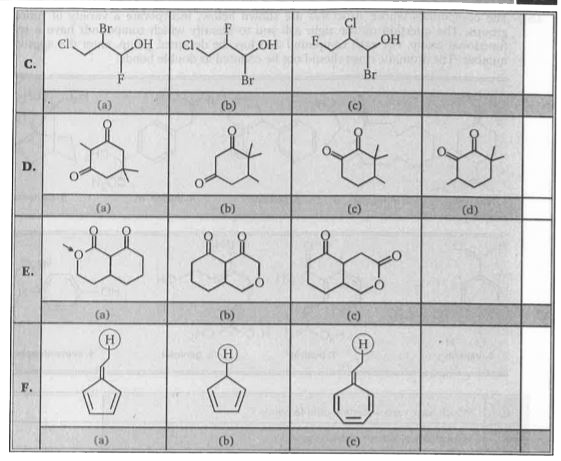Compare the acid strengths of the following:
Acetic acid and propanoic acid
To compare the acid strengths of acetic acid (CH₃COOH) and propanoic acid (CH₃CH₂COOH), we need to analyze the stability of their corresponding anions after they dissociate in an aqueous solution.
Step 1: Write the dissociation equations
Both acids dissociate in water to produce their respective anions and hydrogen ions (H⁺).
- Acetic Acid:
CH3COOH⇌CH3COO−+H+
- Propanoic Acid:
CH3CH2COOH⇌CH3CH2COO−+H+
Step 2: Analyze the stability of the anions
The strength of an acid is determined by the stability of its conjugate base (the anion formed after dissociation). The more stable the anion, the stronger the acid.
- Acetate Ion (CH₃COO⁻):
The acetate ion has one methyl group (CH₃) attached to the carboxylate group. The electron-donating effect of this group can destabilize the negative charge on the oxygen atom.
- Propionate Ion (CH₃CH₂COO⁻):
The propionate ion has two carbon atoms (one ethyl group, CH₃CH₂) attached to the carboxylate group. This additional carbon chain also has an electron-donating effect, which can further destabilize the negative charge on the oxygen atom.
Step 3: Compare the electron-donating effects
In acetic acid, there is only one methyl group donating electron density, while in propanoic acid, there are two carbon groups (one ethyl and one methyl) that can donate electron density.
- The acetate ion (CH₃COO⁻) is more stable than the propionate ion (CH₃CH₂COO⁻) because the single methyl group provides less electron donation compared to the two groups in propanoic acid.
Step 4: Conclusion
Since the acetate ion is more stable than the propionate ion, acetic acid is a stronger acid than propanoic acid. Therefore, we conclude that:
Acetic Acid (CH3COOH)>Propanoic Acid (CH3CH2COOH)
Summary
Acetic acid is a stronger acid than propanoic acid due to the greater stability of its conjugate base (acetate ion) compared to that of propanoic acid (propionate ion).
---
Both acids dissociate in water to produce their respective anions and hydrogen ions (H⁺).
CH3COOH⇌CH3COO−+H+
CH3CH2COOH⇌CH3CH2COO−+H+
The strength of an acid is determined by the stability of its conjugate base (the anion formed after dissociation). The more stable the anion, the stronger the acid.
The acetate ion has one methyl group (CH₃) attached to the carboxylate group. The electron-donating effect of this group can destabilize the negative charge on the oxygen atom.
The propionate ion has two carbon atoms (one ethyl group, CH₃CH₂) attached to the carboxylate group. This additional carbon chain also has an electron-donating effect, which can further destabilize the negative charge on the oxygen atom.
In acetic acid, there is only one methyl group donating electron density, while in propanoic acid, there are two carbon groups (one ethyl and one methyl) that can donate electron density.
Since the acetate ion is more stable than the propionate ion, acetic acid is a stronger acid than propanoic acid. Therefore, we conclude that:
Acetic acid is a stronger acid than propanoic acid due to the greater stability of its conjugate base (acetate ion) compared to that of propanoic acid (propionate ion).
Topper's Solved these Questions
- ALDEHYDES, KETONES AND CARBOXYLIC ACIDSBOOK - ICSECHAPTER - ALDEHYDES, KETONES AND CARBOXYLIC ACIDSEXERCISE - ISC EXAMINATION QUESTIONS (PART-I OBJECTIVE QUESTIONS) (FILL IN THE BLANKS)
27 Videos
- ALDEHYDES, KETONES AND CARBOXYLIC ACIDSBOOK - ICSECHAPTER - ALDEHYDES, KETONES AND CARBOXYLIC ACIDSEXERCISE - ISC EXAMINATION QUESTIONS (PART-I OBJECTIVE QUESTIONS) (MULTIPLE CHOICE QUESTION)
24 Videos
- ALDEHYDES, KETONES AND CARBOXYLIC ACIDSBOOK - ICSECHAPTER - ALDEHYDES, KETONES AND CARBOXYLIC ACIDSEXERCISE - EXERCISE (PART-II DESCRIPTIVE QUESTIONS) (VERY SHORT QUESTIONS)
282 Videos
- ALCOHOLS, PHENOLS AND ETHERS BOOK - ICSECHAPTER - ALCOHOLS, PHENOLS AND ETHERS EXERCISE - ISC EXAMINATION QUESTIONS
25 Videos
- APPENDIX II ( TYPICAL CONVERSIONS)BOOK - ICSECHAPTER - APPENDIX II ( TYPICAL CONVERSIONS)EXERCISE - AROMATIC CONVERSIONS
98 Videos
Similar Questions
Knowledge Check
Compare acidic strength of the following compound.
 AP>Q>RBQ>P>RCR>P>QDR>Q>P
AP>Q>RBQ>P>RCR>P>QDR>Q>P
Compare acidic strength of

View SolutionCompare the acidic character of the following:

View SolutionWhich of the following represents the correct decreasing order of acidic strength of following ?
(i)Methanoic acid
(ii)Ethanoic acid
(iii)Propanoic acid
(iv)Butanoic acid
View SolutionCompare acidic strength of the following (Write your answer in box).


View SolutionArrange increasing order of acidic strength of following dibasic acids:
(I) oxalic acid. (II) succinic acid (III) malonic acid (IV) adipic acid
View SolutionFind the correct order of acid strength of the following acids in aqueous solution
View SolutionWhich of the following is soluble in acetic acid?
View Solution
